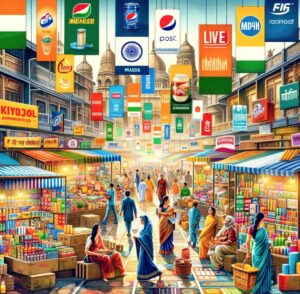Introduction
In the Indian consumer goods market, ITC, Hindustan Unilever (HUL), Nestlé India, and Dabur India are all dominant players. They operate in similar sectors, yet each has its own distinct business model, market strategies, and product offerings. This comparison provides a detailed analysis of their financial performance, strategic outlook, business strengths, market segments, and competitive positioning, highlighting how each company stacks up in the consumer goods landscape.
1. ITC Limited
Business Model
ITC is a diversified conglomerate with a significant presence in FMCG (Fast-Moving Consumer Goods), hotels, paperboards, packaging, and agri-business. Though its FMCG business is a key contributor, ITC is also known for its strong performance in the tobacco segment, particularly with its flagship brand, Gold Flake. Over recent years, ITC has made significant inroads into the food, personal care, and lifestyle categories, focusing on expanding its product offerings to reduce reliance on tobacco.
Key Strengths
- Diversification: ITC’s business diversification across multiple segments provides stability. Its FMCG segment includes brands like Aashirvaad, Sunfeast, Bingo, and Fiama.
- Brand Power in Tobacco: Its leadership in the tobacco segment contributes significantly to its profitability, with strong margins from this high-margin business.
- Innovation: ITC has been investing heavily in product innovation, particularly in the food and personal care categories, to compete with FMCG giants.
Key Weaknesses
- Tobacco Dependency: Despite diversification, tobacco remains a major revenue contributor, which exposes ITC to regulatory risks and anti-tobacco movements.
- Slow FMCG Growth: While the FMCG segment is growing, it still lags behind HUL and Nestlé India in terms of market share and growth rate.
Financials (FY 2023-24)
- Revenue: ₹18,777 crores (approx.)
- Profit After Tax (PAT): ₹6,738 crores
- EBITDA Margin: 41.5% (strong margins from its tobacco business)
- Market Capitalization: ₹5.5 Trillion (approx.)
2. Hindustan Unilever (HUL)
Business Model
HUL, a subsidiary of the UK-based Unilever Group, is India’s largest FMCG company, operating across diverse segments including home care, personal care, foods and refreshments, and healthcare. The company’s massive distribution network and deep penetration into rural markets make it a formidable player. HUL’s extensive portfolio includes brands like Lifebuoy, Dove, Lipton, and Hellmann’s, which command a large share of the Indian consumer market.
Key Strengths
- Market Leadership: HUL dominates various product categories such as soaps, shampoos, tea, and packaged foods.
- Distribution Network: Its extensive distribution network across rural and urban areas gives it a strong foothold in India’s vast consumer base.
- Brand Equity: HUL boasts some of the strongest and most trusted brands in India.
- Sustainability Initiatives: HUL has a significant focus on sustainability, which aligns with global consumer preferences for eco-friendly and socially responsible brands.
Key Weaknesses
- Margin Pressure: Increased competition in various categories has pressured profit margins.
- Dependency on Developed Markets: HUL still derives a significant portion of its revenue from developed markets like Europe, which can expose the company to currency fluctuations and economic slowdowns in these regions.
Financials (FY 2023-24)
- Revenue: ₹55,000 crores (approx.)
- Profit After Tax (PAT): ₹9,446 crores
- EBITDA Margin: 23.4%
- Market Capitalization: ₹7.5 Trillion (approx.)
3. Nestlé India
Business Model
Nestlé India, a subsidiary of the Swiss food and beverage giant Nestlé, is primarily involved in the packaged foods and beverages segment. It’s best known for iconic brands like Maggi noodles, Nescafé coffee, KitKat, and Nestea. Unlike ITC and HUL, Nestlé has a singular focus on food and beverages, making it less diversified but highly specialized. Nestlé India is heavily reliant on its food segment, with the majority of its revenues coming from instant noodles, milk products, and chocolates.
Key Strengths
- Strong Brand Portfolio: Nestlé India owns some of the most recognized and trusted food brands in India.
- Category Leadership: Maggi remains the dominant player in the instant noodles segment, and Nescafé is a leader in the coffee market.
- Focus on Nutrition: Nestlé India has increasingly focused on healthier food options, aligning with changing consumer preferences.
Key Weaknesses
- Supply Chain Vulnerability: Nestlé India faces occasional challenges with supply chain management, especially with perishable goods like dairy.
- Regulatory Hurdles: As with all major food companies, Nestlé has occasionally faced regulatory challenges around food safety and labeling.
Financials (FY 2023-24)
- Revenue: ₹16,000 crores (approx.)
- Profit After Tax (PAT): ₹2,500 crores
- EBITDA Margin: 21.9% (strong margins due to premium product offerings)
- Market Capitalization: ₹2.5 Trillion (approx.)
4. Dabur India
Business Model
Dabur India has carved a niche in the health, wellness, and natural products market. Its portfolio spans healthcare, personal care, and food products, with strong brands like Dabur Amla, Vatika, Real, and Hajmola. Dabur’s focus on Ayurveda and natural ingredients has resonated well with Indian consumers, especially those seeking healthier alternatives. Dabur’s strength lies in its wide reach in the rural markets and its cost-effective product offerings.
Key Strengths
- Strong Health Focus: Dabur has successfully capitalized on the rising demand for health and wellness products, offering Ayurvedic and herbal solutions.
- Wide Rural Penetration: Dabur’s deep penetration into rural markets provides a competitive edge.
- Brand Recognition: The brand’s reputation for using natural ingredients appeals to a health-conscious consumer base.
Key Weaknesses
- Narrow Product Range: Compared to the more diversified companies like HUL, Dabur has a relatively narrower product range.
- Competitive Pressure: With the increasing popularity of natural and organic products, Dabur faces stiff competition from newer entrants in the wellness market.
Financials (FY 2023-24)
- Revenue: ₹12,500 crores (approx.)
- Profit After Tax (PAT): ₹1,750 crores
- EBITDA Margin: 20.1%
- Market Capitalization: ₹1.4 Trillion (approx.)
Comparative Analysis
| Parameter |
ITC |
HUL |
Nestlé India |
Dabur India |
| Market Segments |
Tobacco, FMCG, Hotels, Agri |
FMCG, Personal Care, Foods, Beverages |
Packaged Foods, Beverages |
Health, Wellness, FMCG |
| Key Brands |
Aashirvaad, Sunfeast, Gold Flake |
Lifebuoy, Dove, Lipton, Hellmann’s |
Maggi, Nescafé, KitKat |
Dabur Amla, Vatika, Real, Hajmola |
| Strengths |
Diversification, Tobacco Dominance |
Market Leader, Distribution Network |
Iconic Brands, Focus on Nutrition |
Natural Products, Rural Reach |
| Weaknesses |
Tobacco Dependency, Slow FMCG Growth |
Margin Pressure, Developed Market Dependency |
Supply Chain Issues, Regulatory Risks |
Narrow Range, Competitive Pressure |
| Revenue Growth |
Steady, driven by FMCG and tobacco |
Consistent, driven by FMCG |
Steady, driven by food and beverages |
Consistent, driven by wellness |
| Profit Margins |
High due to tobacco business |
Strong, but pressured |
High due to premium products |
Healthy, cost-effective range |
| Revenue (FY 2023-24) |
₹18,777 crores |
₹55,000 crores |
₹16,000 crores |
₹12,500 crores |
| PAT (FY 2023-24) |
₹6,738 crores |
₹9,446 crores |
₹2,500 crores |
₹1,750 crores |
| Market Cap (2024) |
₹5.5 Trillion approx. |
₹7.5 Trillion approx. |
₹2.5 Trillion approx. |
₹1.4 Trillion approx. |
Conclusion
Each company has its unique competitive advantages and challenges. ITC excels with its diversified portfolio, particularly in the tobacco space, while Hindustan Unilever (HUL) remains the undisputed leader in the FMCG sector, with a broad market presence and top-tier brands. Nestlé India, although more narrowly focused, continues to dominate the packaged food and beverage sector with iconic products, while Dabur India stands out for its focus on wellness and natural products, with a strong presence in rural markets. Depending on consumer preferences, growth expectations, and risk appetites, investors may find different strengths in each company.



